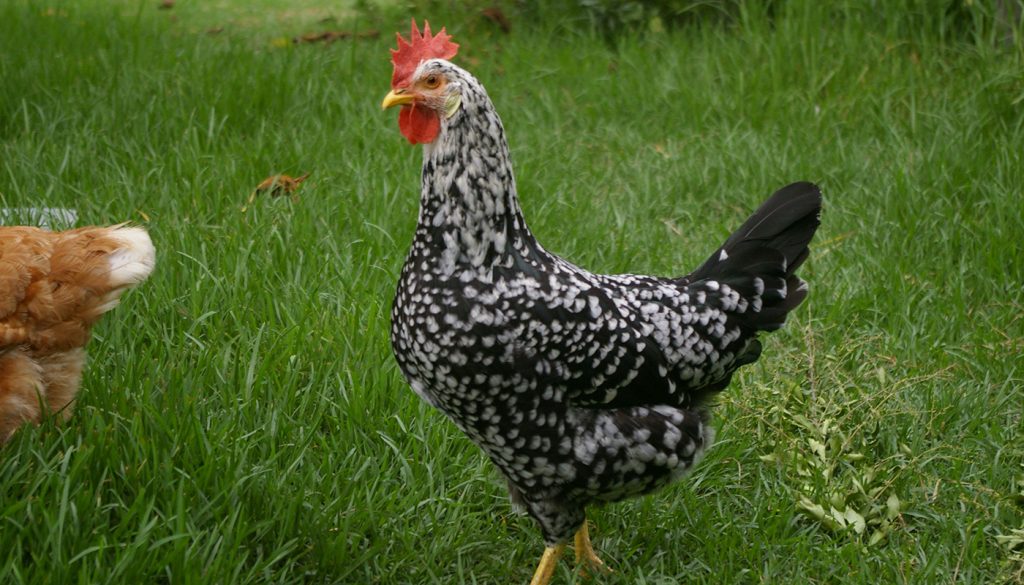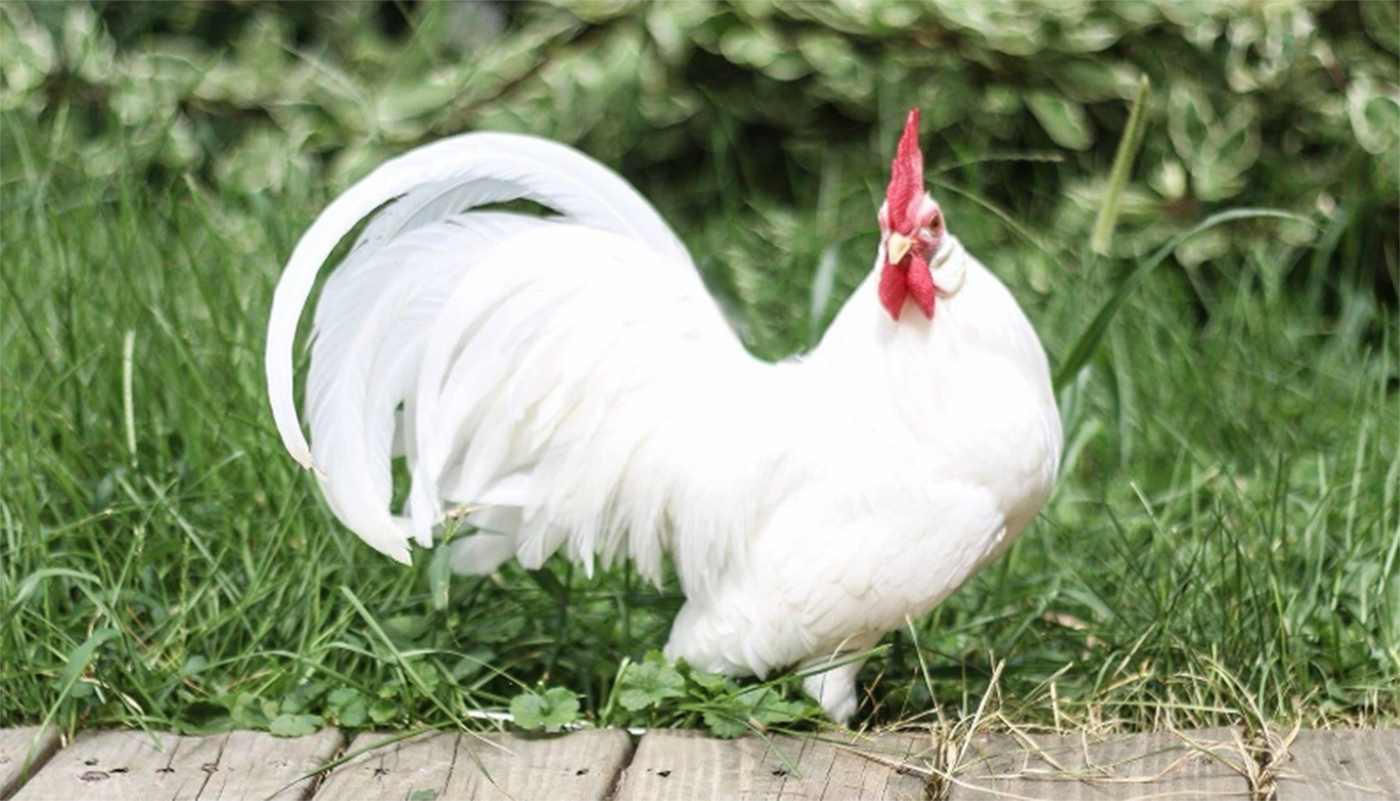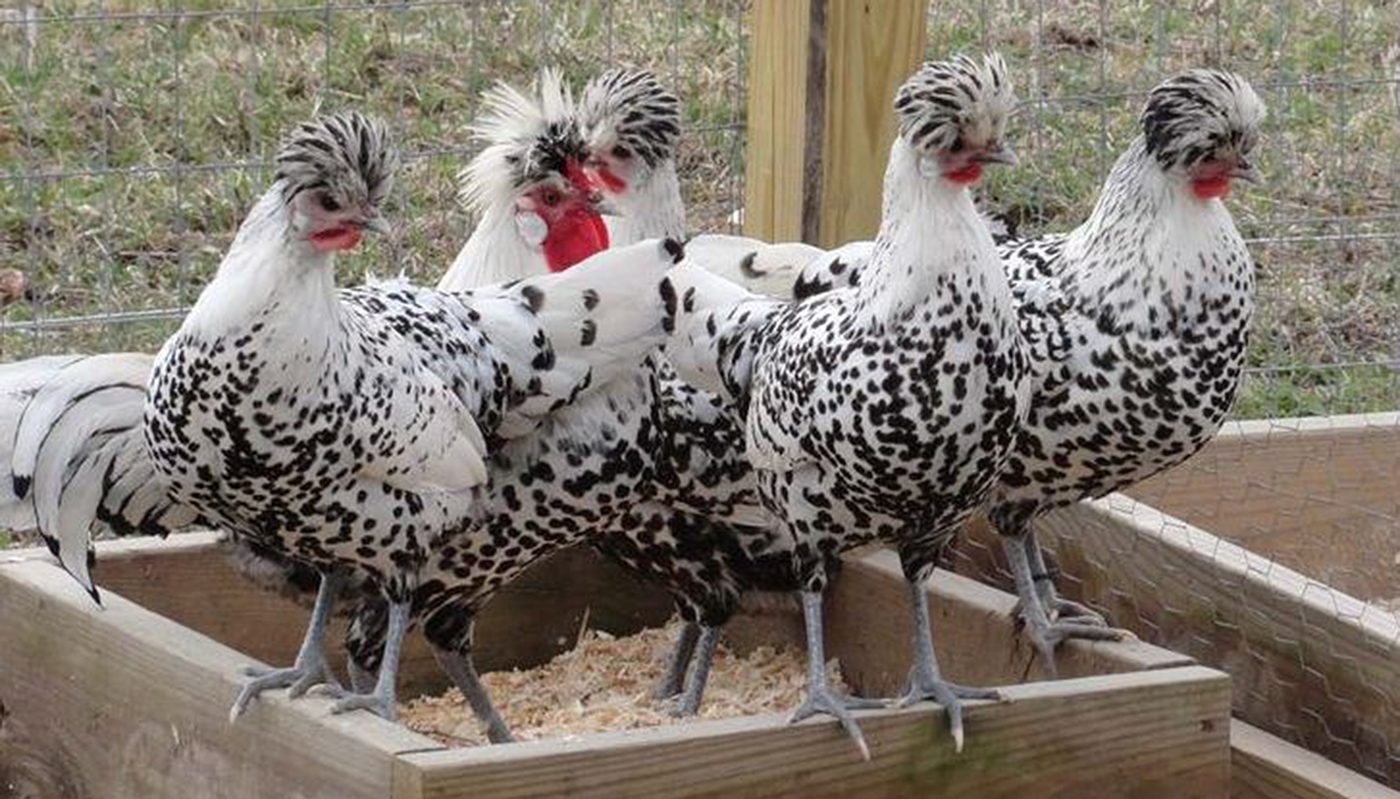
This bird is named after the city Ancona which is the capital of Marche in Italy.
Originally bred for eggs this bird is quite popular in the United Kingdome and America. This bird is mostly black and mottled with one feather in every three ending in a V-shaped white marking at the tip. These markings grow larger every time the bird moults making the larger white tips on birds a telltale of its age. They have unusual yellow mottled legs and some of them have a beetle-green sheen to their feathers.
They are great egg layers and some hens start laying as early as five months old.
Although this hardy chicken originates from Italy and was once in abundance throughout the country they are very rarely seen there these days. An initiative has been started in Italy to get these chickens re-established in their country of origin.
HISTORY
The Ancona has its roots in central Italy in the city of Ancona after which it was named. They were bred from a range of breeds and Leghorns. They were once originally known as Black Leghorns and were the primary egg producers for Europe. They were brought over to America in the nineteenth century, the single-comb Ancona was first recognized by the American Poultry Association in 1898 and the rose-comb Ancona in 1914.
Although both England and America recognize both the single-comb and rose-comb breeds Italy only accepts the rose comb, Ancona.
These birds are rather weather hardy and adjust to any climate be it the heat or the cold.
The very first Ancona chickens were imported to England in 1851 and selectively bred for their markings. One breeder named Cobb showed the first Ancona’s in Britain in 1880. The first rose-comb Ancona was shown in Birmingham in 1910.
CHARACTERISTICS |
|
|---|---|
| Country of Origin: | Italy |
| American Poultry Association: | Recognized as a breed of chicken in the United States |
| Chicken Category: | Large Breed |
| Chicken Class: | Mediterranean |
| Bantam Variety Available? | Yes |
| Related | TOP 10 BANTAM CHICKEN BREEDS FOR BEGINNERS |
IDENTIFICATION⇒ |
Appearance: They are beautiful birds with shiny black plumage tipped with white.
Their bodies are well feathered, and their long clean yellow legs are mottled with black. Their skin is also yellow.
Color(s): Both the hens and roosters have black feathers with V-shaped white tips on some feathers.
Comb: The hands a single comb that flops over on the hens but stands up on roosters and some also have a rose-comb.
Ave. Weight: Hens/Pullet 4.6 lbs.
Cockerel 6.17 lbs. |
| Life Expectancy: | The average lifespan is 8 years but has been known to live up to 14 years in the correct environment. |
| Good Starter Chicken? | They are a great starter chicken with their wonderful natures. |
| Related | 10 BEST STARTER CHICKENS FOR THE FIRST TIME POULTRY KEEPER |
PURPOSE⇒ |
Eggs: They are very good egg layers.
They lay medium to large white eggs up to 280 per year They are steady layers all year round. They start to lay eggs from around 5 months old.
Meat: Their yellow skin and meaty bodies make them a tasty table bird.
Breeding: They can be bred but these hens are not the broody mothering type.
Breeding them as show birds is a really good idea as these beauties are the pride of any poultry show. The baby chicks have blacktop wings and yellow bodies making them look like they are wearing a black cape. For advice on breeding please check our guide to breed poultry. If you are a first-time breeder it is best to get professional advice from your local animal shelters, poultry farmers or vet.
Foraging: Free-ranging through the garden is a must for these socially active chickens. Foraging is their favorite past time.
Show Bird: Ancona makes a beautiful show bird
Pets: They make great pets that love to chat
Other: They can be tamed and become quite attached to their humans
They will give your organic garden a lot of nutritious fertilizer to give your garden a boost. |
| Health: | They may be prone to frostbite but overall do not have health issues. |
| You may Also Like: | HOW TO TELL IS A CHICKEN IS SICK |
| Temperament: | These birds are a very popular backyard chicken in America and England as they are friendly, active birds that display remarkable intelligence and are excellent egg layers. |
| Flyers? | A flighty bird that flies very well. |
| Noisy Birds? | As they are sociable creatures they tend to be rather noisy. |
| Interaction with other chickens: | Socializing well with any other chicken in your flock. They are the socialites of chickens and will do their best to interact with all the other breeds in your flock. As with any flock if you are introducing new birds it is best to slowly socialize them with the flock. |
| Good with kids? | They love to play with the kids and will be an endless delight. |
| Related | 10 ROOSTER BREEDS THAT DO NOT MIND CHILDREN |
| Socialize Behavior? | These chickens will chat and socialize with any animal willing to listen and put up with them. |
| You may Also Like: | HOW TO SOCIALIZING YOUR NEW CHICKENS |
| Known predators: | Most domestic animals leave them alone, but it is always best to keep an eye on dogs and cats. If hawks and or foxes are in your area it is always best to take precautions. Check with local animal shelters, zoos, vets, animal control and or pet stores about common predators in your area. |
| Conservation Status: | These birds conservation status is recorded as “watch”. It is best to check on any special license or instructions that may be set up for owning these birds. This can be checked with your local or national conservation centers. |
IDEAL ENVIRONMENT⇒ |
Garden Size: The Ancona likes to wander about and explore so tends not to take to confinement too well. They will adapt to most garden sizes but are better for the medium to the larger garden.
Ideal Climate: A hardy breed that adapts well to most climates.
Ideal Coop: The rule of thumb for any coop is 50 cm x 50 cm per hen/rooster in the coop.
Ensure there is a good space for the nesting boxes and nightly roosting rails at least 1.5 inches wide. Good ventilation for air but not too drafty especially in winter. It is always a good idea to raise the coop off the ground to give the birds a dry place to roost and lay especially in wet weather.
Ideal Coop Run: Ancona’s are flighty and do love to fly so it is best to have an enclosed chicken run.
Ideal Flock Size: They do need to have at least three in their flock.
Special Instructions: Their grooming is done by them as they love to primp and preen their pretty feathers.
Accessories: The following accessories are ideal for your coop:
Nesting boxes Straw for the boxes and roosting area Roosting rails Perches Water troughs/bowls Food bowls/feeders Heating lamp(s) Animal carrier for transport purposes |
| You may Also Like: | 45 FREE DIY CHICKEN COOP PLANS, TUTORIALS AND DESIGNS |
WHERE TO FIND THESE BIRDS TO ADD TO YOUR FLOCK
Ancona’s are fairly rare breed to find but there are several large hatcheries that do sell them.
Some of these hatcheries do advertise through various reputed poultry outlets and farms, but it is best to check with your local conservation centers and any breeding clubs as they are a registered breed. If you plan on breeding your chickens, you will want to make sure that they are from a good bloodline.
CARING FOR THE BIRD(S)
Please click here for our full guide to “Taking care of chickens”. This is a comprehensive guide to owning chickens. It covers where to start from choosing your ideal flock, the coop that would best suit your garden, your bird and you to buying and bringing your bird(s) home.
GENERAL
These ladies are very active and really chatty. They are sure to keep you and your family thoroughly entertained. Their naturally inquisitive nature will have them following the kids about the garden to see what they are doing and even try to join in if they can. A great gardening companion who will even keep you company when you are hanging up the washing. If nurtured correctly they do not mind being handled and will run to greet you every morning.
GROOMING
Always check your ladies (and gent) for pests like mites, lice and various other parasites. This is advisable to do at least once a week. As with any domestic animal especially if they are going to be around kids they must be de-wormed on a regular basis. If you have their wings clipped to make sure this is done after every moult of they will take off as soon as their wing has grown back. These chickens love to fly and see what is over the fence.
A nice dust bath or two set up around the garden is sure to give them endless delight as they do love to primp and preen.
DIET AND NUTRITION
These birds do love to indulge in tasty table scraps eating most vegetable or fruit leftovers. Their morning should start with their normal feed such as chicken pellets, grains, chicken mash or grain mix from 8 weeks old and older.
For baby chickens, the best is always Chick Starter when they are under 8 weeks old.
Laying hens should get extra protein and calcium in their diets to ensure the quality of their eggs and to keep them in tip-top health.
Please see our comprehensive guide to “Feeding your chickens” for more information of the different types of chicken feed for chicks, hens, laying hens, roosters, etc. and where to buy the feed and approximate cost of the feed.
SOCIALIZING THE BIRD(S)
The Ancona is one of the most sociable chicken breeds and will welcome others into their flock. Their overly active natures may stress some chickens out, so it is always best to take all the necessary socializing new birds precautions.
Always check on how well a breed will get on with your current flock before buying them as you do not want to upset your coop or stress your current flock.
Most breeds of varying temperaments are quite suitable to be integrated with the Ancona’s.
As with any newcomer to the roost, you will have to quarantine the bird for 7 – 31 days to ensure it does not have any unwanted critters or disease that could spread to your current flock.
These socialites may be chatty, accepting and welcoming but they too have a pecking order that any newcomer will have to adhere too. Following the strict socializing your chicken’s guidelines is always best as not upset the delicate social order and balance of your current flock. After all, they are quite the ladies!
NOTES / SPECIAL INSTRUCTIONS
As they are registered as a “watch” conservation status they may need an extra license to own or keep in your garden. For advice on what the bird’s conservation status and orders are please check with your local conservation department.
For breeders, it is imperative that you always check your bird’s bloodlines and ensure you are buying your birds from a reputed breeder/farm. In order to sell birds of such stature, they have to be recorded and documented, always check with local animal breeding organizations for these records.
These legitimate documents are also required should you wish to show your bird(s) in various poultry shows/competition showings.
For information and advice on adopting rescued animals, you can visit or contact your local animal welfare center.
Video
USEFUL LINKS
- Caring for your Chicken
- Feeding
- Health
- Socializing your Chicken
- Breeding Chicken
- Raising Chickens A-Z
- Hatching Eggs
- What is Molting
- Animal Shelter (ASPCA)
- American Veterinary Medical Association
- American Poultry Association
- American Animal Welfare Society
- American Animal Control
- American Animal Husbandry Society
References
- https://en.wikipedia.org
- https://livestockconservancy.org
- https://www.roysfarm.com
- https://www.mypetchicken.com
- https://www.backyardchickens.com
- https://www.feathersite.com/
 Modern Game Chicken Breed – Everything You Need to Know
Modern Game Chicken Breed – Everything You Need to Know CONDITIONS THAT AFFECT THE NERVOUS SYSTEM OF CHICKENS
CONDITIONS THAT AFFECT THE NERVOUS SYSTEM OF CHICKENS Leghorn Chicken Breed – Everything You Need to Know
Leghorn Chicken Breed – Everything You Need to Know Australorp Chicken Breed – Everything You Need to Know
Australorp Chicken Breed – Everything You Need to Know Cochin Chicken Breed – Everything You Need to Know
Cochin Chicken Breed – Everything You Need to Know CONDITIONS THAT AFFECT A CHICKENS VENT
CONDITIONS THAT AFFECT A CHICKENS VENT Houdan Chicken Breed – Everything You Need to Know
Houdan Chicken Breed – Everything You Need to Know Bearded D’Anvers Bantam Chicken Breed – Everything You Need to Know
Bearded D’Anvers Bantam Chicken Breed – Everything You Need to Know CONDITIONS THAT AFFECT THE EYES OF A CHICKEN
CONDITIONS THAT AFFECT THE EYES OF A CHICKEN Appenzeller Chicken Breed – Everything You Need to Know
Appenzeller Chicken Breed – Everything You Need to Know Silkie Chicken Breed – Everything You Need to Know
Silkie Chicken Breed – Everything You Need to Know Top 10 Bantam Chicken Breeds for Beginners
Top 10 Bantam Chicken Breeds for Beginners